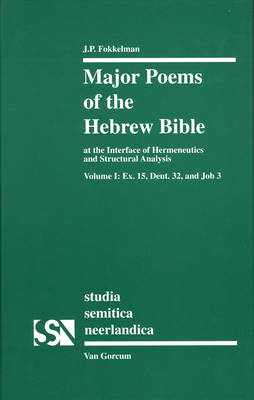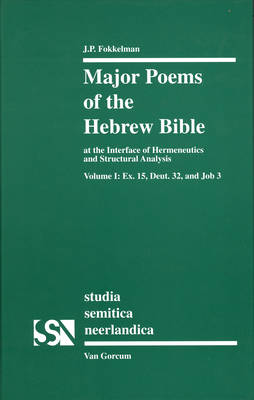
Je cadeautjes zeker op tijd in huis hebben voor de feestdagen? Kom langs in onze winkels en vind het perfecte geschenk!
- Afhalen na 1 uur in een winkel met voorraad
- Gratis thuislevering in België vanaf € 30
- Ruim aanbod met 7 miljoen producten
Je cadeautjes zeker op tijd in huis hebben voor de feestdagen? Kom langs in onze winkels en vind het perfecte geschenk!
- Afhalen na 1 uur in een winkel met voorraad
- Gratis thuislevering in België vanaf € 30
- Ruim aanbod met 7 miljoen producten
Zoeken
Major Poems of the Hebrew Bible
At the Interface of Hermeneutics and Structural Analysis, Volume I: Ex. 15, Deut. 32, and Job 3
Jan Fokkelman
€ 224,45
+ 448 punten
Uitvoering
Omschrijving
This book presents a comprehensive discussion of three famous poems which are studied as works of art. A full description of their prosodic regularity, as well as the variations on it, is given, and goes hand in hand with a detailed structural analysis of the lower and higher textual units. Great care is taken to find the correct delimitation of cola (half-verses), verses, strophes and stanzas, and, in the case of Deut.32, of its four big sections, after which all things fall into place.
The articulation of the higher units underpins the discursive or argumentative structure of Deut.32 and Job 3 and is a solid basis for an interpretation that tries to honour the thematic developments in these songs. In the case of Ex.15, of which the stanzaic division is already known, the attention shifts to the lower levels. The contours and rhythms of its short cola, and its verses and strophes are studied and accounted for. The chapter on Job 3 has a special feature. The count of premasoretic syllables is shown to be an essential part of the numerical perfection of this poem.
A major point of departure for this book, which is corroborated by its results, is that these poems are so complex (read: of such many-layered significance) that they cannot be given their due by a simple set of techniques or fixed canon of interpretive procedures. This poetry requires a flexible approach which tries to cover the full range of its brilliant usage of language, style and structure.
The articulation of the higher units underpins the discursive or argumentative structure of Deut.32 and Job 3 and is a solid basis for an interpretation that tries to honour the thematic developments in these songs. In the case of Ex.15, of which the stanzaic division is already known, the attention shifts to the lower levels. The contours and rhythms of its short cola, and its verses and strophes are studied and accounted for. The chapter on Job 3 has a special feature. The count of premasoretic syllables is shown to be an essential part of the numerical perfection of this poem.
A major point of departure for this book, which is corroborated by its results, is that these poems are so complex (read: of such many-layered significance) that they cannot be given their due by a simple set of techniques or fixed canon of interpretive procedures. This poetry requires a flexible approach which tries to cover the full range of its brilliant usage of language, style and structure.
Specificaties
Betrokkenen
- Auteur(s):
- Uitgeverij:
Inhoud
- Aantal bladzijden:
- 216
- Taal:
- Engels
- Reeks:
- Reeksnummer:
- nr. 37
Eigenschappen
- Productcode (EAN):
- 9789023233671
- Verschijningsdatum:
- 1/01/1998
- Uitvoering:
- Hardcover
- Formaat:
- Genaaid
- Afmetingen:
- 170 mm x 250 mm
- Gewicht:
- 557 g

Alleen bij Standaard Boekhandel
+ 448 punten op je klantenkaart van Standaard Boekhandel
Beoordelingen
We publiceren alleen reviews die voldoen aan de voorwaarden voor reviews. Bekijk onze voorwaarden voor reviews.









